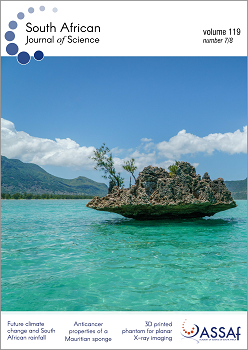Elemental, phytochemical, and toxicological assessment of Cissus rotundifolia (Forssk.) Vahl
DOI:
https://doi.org/10.17159/sajs.2023/13160Keywords:
Cissus rotundifolia, heavy metals, nutritional value, phytosterol, pheophytinAbstract
Cissus rotundifolia (Forssk.) Vahl. (Vitaceae) is a wild plant that is commonly used by communities from rural areas as a food and medicine. There are limited studies on the phytochemical composition and the impact of soil quality on the elemental distribution in this plant. In this study, we report a phytochemical analysis to identify the phytocompounds responsible for the reported biological activities of C. rotundifolia. We also examined the impact of soil quality on elemental uptake by the edible parts of C. rotundifolia collected from eight geographical locations in KwaZulu-Natal (South Africa) to assess the nutritional benefits and potential heavy metal toxicities. Three secondary metabolites (stigmasterol, β-sitosterol, and pheophytin a) were isolated, and their structures were characterised by high-resolution mass spectrometry and nuclear magnetic resonance data. The plant was found to contribute adequately to the recommended dietary allowances for essential nutrients without exceeding tolerable upper intake limits and with low concentrations of toxic heavy metals. The average concentrations of microelements in the edible parts were found to be in decreasing order of Fe>Mn>Se>Zn>Cu>Cr>Ni>Co. The bioaccumulation factors indicate that the plant controls the uptake of metals from the soil and would make a good indicator and biological monitor for cadmium toxicity. However, a health risk assessment exposed carcinogenic risks on regular consumption of the plant obtained from sites close to pollution sources, such as roads and landfills. The findings from this study show the synergies when consuming medicinal plants and provide evidence for C. rotundifolia as a nutraceutical.
Significance:
This study provides additional scientific knowledge on the phytochemical composition of C. rotundifolia. Three phytocompounds (stigmasterol, β-sitosterol, and pheophytin a) were isolated, and their presence may be correlated to this plant’s antidiabetic, anti-inflammatory, and antibacterial properties. This study shows that C. rotundifolia contributes adequately to the recommended dietary allowances for essential elements, and the plant is safe for human consumption if collected from non-polluted sites. The carcinogenic and non-carcinogenic estimates for the toxic metals due to consumption of the plant signify the possibility of developing cancer over time if the plant is consumed frequently from polluted sites.
Published
Issue
Section
License

All articles are published under a Creative Commons Attribution 4.0 International Licence
Copyright is retained by the authors. Readers are welcome to reproduce, share and adapt the content without permission provided the source is attributed.
Disclaimer: The publisher and editors accept no responsibility for statements made by the authors
How to Cite
- Abstract 282
- PDF 642
- EPUB 170
- XML 193












.png)